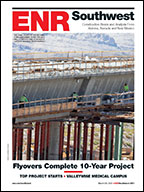An ongoing U.S. Dept. of Labor probe into how well states are recovering budget overruns on big federally funded transportation projects has engineering firms worried that design errors and omissions may become the primary cost culprit.
Company executives at the annual meeting earlier this month of the American Council of Engineering Companies (ACEC) in Colorado Springs, Colo., noted the audit of four states by DOTs Office of the Inspector General, which began last October. Many speculated it is an outgrowth of agency concern over big cost overruns on the $14.6-billion Central Artery/Project in Boston.
Engineers are concerned that the IG probe may be unfairly targeting design errors and omissions as the cause of project cost overruns, as investigators analyze whether and how states are tracking and recovering enough of these funds for the Federal Highway Administration. The IG seems to have a zero tolerance on errors and omissions, but it is unclear as to definitions, says one executive.
IG spokesman David Barnes would not confirm the states under study, but sources mention Florida, Virginia, Illinois and Arizona. He says it was undertaken in response to a 2001 federal study that identified design E&O as a leading factor in highway project delays and cost overruns. DOT also believes some states have been lax in cost oversight and recovery.
|
ACEC member executives, who decline to go on the record as they continue to talk with IG representatives in the unfolding audit, worry that designers could be made responsible for costs not of their making. Its easy to check the design-error box on claims, says one. Maybe its E&O, but everything should not be lumped in.
Barnes would not confirm that the IG audit would finish in September, as design executives speculate, but they worry that the results could find their way into new FHWA cost recovery rules. Sources add that state officials also are not looking forward to costly new project accounting mandates.
ACEC executives also hotly debated the merits of sending engineering and other company tasks to sources outside the U.S. But public confusion over the term for this trend seemed to agitate convention attendees just as much. While design executives use offshoring, the label of outsourcing has frequently been attached in the media, with negative connotations, they say. Executives worry that the outsourcing label could be confused with the trend to privatize government work, an emerging source of revenue for many firms. Unions skillfully confuse the issue to derail government outsourcing, said Steven Hall, ACEC vice president of government affairs.
Some executives of large engineering firms appeared split on business benefits of offshoring versus its public relations liabilities. Firms in our industry have been doing it as a way of business for a long time, said one executive. Others worry that it could cost U.S. jobs. Small firms are petrified that they will be decimated, said one executive of a 22-person structural engineer. New ACEC Chairman William S. Howard, executive vice president of Camp Dresser & McKee Inc., says the group is probing the trend.


Post a comment to this article
Report Abusive Comment